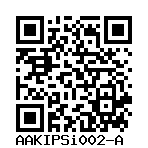AAKIPSi002-A
General
Cell Line |
|
| hPSCreg name | AAKIPSi002-A |
| Cite as: | AAKIPSi002-A (RRID:CVCL_A5PK) |
| Cell line type | Human induced pluripotent stem cell (hiPSC) |
| Similar lines |
ESi077-A (CABi001-A, PRPF31-MiPS4F3) Donor's gene variants: PRPF31, PRPF31 Donor diseases: Retinitis Pigmentosa |
| Last update | 26th April 2022 |
| User feedback | |
Provider |
|
| Generator | INSTITUT NATIONAL DE LA SANTÉ ET DE LA RECHERCHE MÉDICALE (AAKIPS) |
| Owner | INSTITUT NATIONAL DE LA SANTÉ ET DE LA RECHERCHE MÉDICALE (AAKIPS) |
| Distributors | |
| Derivation country | France |
External Databases |
|
| BioSamples | SAMEA8307196 |
| Cellosaurus | CVCL_A5PK |
| Wikidata | Q107113343 |
General Information |
|
| Publications | |
| * Is the cell line readily obtainable for third parties? |
Yes Cell line can only be used in: Limbal and corneal commitments
Research use: allowed
Clinical use: not allowed
Commercial use: not allowed
|
Donor Information
General Donor Information |
|
| Sex | female |
Phenotype and Disease related information (Donor) |
|
| Diseases | A disease was diagnosed.
|
Karyotyping (Donor) |
|
| Has the donor karyotype been analysed? |
No
|
Other Genotyping (Donor) |
|
| Is there genome-wide genotyping or functional data available? |
No
|
External Databases (Donor) |
|
| BioSamples | SAMEA8307197 |
Ethics
| Has informed consent been obtained from the donor of the embryo/tissue from which the pluripotent stem cells have been derived? | Yes |
| Was the consent voluntarily given? | Yes |
| Has the donor been informed that participation will not directly influence their personal treatment? | Yes |
| Can you provide us with a copy of the Donor Information Sheet provided to the donor? | Yes |
| Do you (Depositor/Provider) hold the original Donor Consent Form? | Yes |
| Please indicate whether the data associated with the donated material has been pseudonymised or anonymised. | anonymised |
| Does consent explicitly allow the derivation of pluripotent stem cells? | Yes |
| Does consent prevent CELLS DERIVED FROM THE DONATED BIOSAMPLE from being made available to researchers anywhere in the world? | No |
| How may genetic information associated with the cell line be accessed? | Controlled Access |
| Will the donor expect to receive financial benefit, beyond reasonable expenses, in return for donating the biosample? | No |
| Has a favourable opinion been obtained from a research ethics committee, or other ethics review panel, in relation to the Research Protocol including the consent provisions? | Yes |
| Name of accrediting authority involved? | MESRI |
| Approval number | IE2018-967 |
| Has a favourable opinion been obtained from a research ethics committee, or other ethics review panel, in relation to the PROPOSED PROJECT, involving use of donated embryo/tissue or derived cells? | Yes |
| Name of accrediting authority involved? | MESRI |
| Approval number | IE-2018-967 |
| For generation of the cell line, who was the supplier of any recombined DNA vectors or commercial kits used? |
hIPSC Derivation
General |
|
| Source cell type |
A peripheral blood cell with a single nucleus. This category includes lymphocytes and monocytes.
Synonyms
|
Reprogramming method |
|
| Vector type | Non-integrating |
| Vector | Sendai virus |
| Is reprogramming vector detectable? |
No |
| Methods used |
PCR, RT-PCR, Sequencing
|
| Files and images showing reprogramming vector expressed or silenced | |
Vector free reprogramming |
|
Other |
|
| Derived under xeno-free conditions |
Unknown |
| Derived under GMP? |
Unknown |
| Available as clinical grade? |
Unknown |
Culture Conditions
| Surface coating | Laminin |
| Feeder cells |
No |
| Passage method | Mechanically |
| Medium |
mTeSR™ 1
|
Characterisation
Analysis of Undifferentiated Cells
Genotyping
Karyotyping (Cell Line) |
|
| Has the cell line karyotype been analysed? |
No
|
Other Genotyping (Cell Line) |
|


Login to share your feedback, experiences or results with the research community.